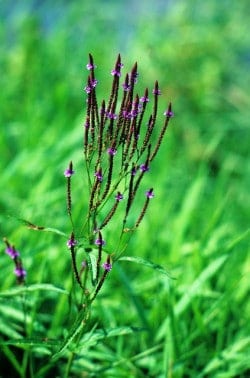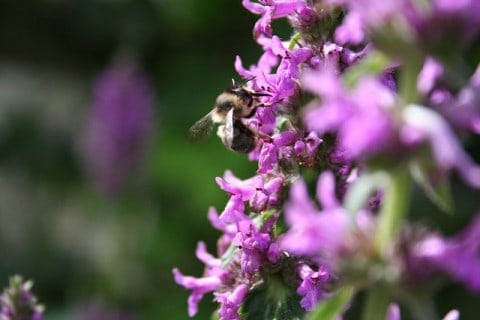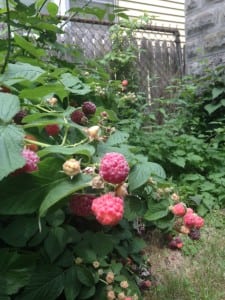Toxins and Terrain
When someone starts to talk about detoxification or cleansing, I often find myself st[r]uck with a question: “What do you mean when you use that word, toxins?” (With echoes of that movie line – you know the one – in the back of my mind.)
The answer is usually one of a handful: the general heavy metals or pollutants, the recursive environmental toxins, the catch-all chemicals; or sometimes something more specific and, usually, acronymical, like PCBs or BPA or EMFs; and somewhat less often these days, parasites or yeast or mold.
Disparate as they might seem, these all share at least a few things in common.

(Photo credit: Don DeBold.)
- They are hidden to the naked eye and nose and tongue, and pass undetected into the body; once there, their presence may be indicated by symptoms, but can be confirmed only through laboratory testing or some other means of detection similarly distanced from direct perception.
- They can be more or less plausibly attributed as the source of almost any set of symptoms a person may be experiencing – either because casually-acquired information on each is easily distilled down to bad! dangerous! harmful! in a very general sense, or because actively-sought information on each will almost inevitably lead to a source that associates that toxin with those [in]exact symptoms.
- The means of elimination for each is thought to be a dynamic and drastic intervention, such as a chemical chelation treatment, a purgative herbal formula, a multi-day fast, or some combination thereof.
We could contest these claims for each suspect substance or species or spirit. We might try proposing a more likely culprit for the symptoms: we could say, for instance, that someone’s IBS and aching joints and depression were all more plausibly the results of a food intolerance than an overload of mercury, or that someone else’s restless leg syndrome and insomnia almost certainly owed more to a magnesium deficiency than to pesticides in their produce. We could then test these theories by a forty-day food elimination or a simple supplementation regimen, and see if the symptoms are relieved by such an approach – one based on fundamental nourishment. (Spoiler: in almost all cases, they will be. Nourish before purging!)
Our use of Occam’s razor in either case is not only to say that these associations are better proven, but also – critically – that the corrective actions they recommend are easier to implement and track.
This would be a 1-to-1 approach, though, and therefore incomplete by design. But we could also approach this category of complaint in a more general way, by re-examining the more fundamental premises on which it rests.
Start from this ground: the visible influences in our lives are more important than the invisible ones.
Like all good grand sweeping generalizations, this one takes some qualifications.

(Photo credit: Matteo Ferraresso.)
And let there be exceptions: a particularly virulent pathogen; a particularly high dose of exposure to one of these accumulative toxins – things that would make anyone, no matter how vital, ill. But that’s still going to be something you can see, if you look: many parasites have visible signs, industrial workplace exposure to chemicals isn’t undetectable, lead paint in old school buildings can be seen – though any of these may go unacknowledged or unrecognized. There is a difference between “mold” and mold, as Katrina and Sandy brought home to so many. And when such factors are a cause of illness, the best strategies for resolution are still centered in supporting the body’s innate healing methods.
Remember, the common concept of toxicity asserts invisible influences slowly accumulated as the problem, and drastic purgative interventions as the solution – but these are mismatched. They conflict with a simple principle: what is accumulated over time must be corrected over time, and what is acute in origin must be treated acutely.
When people do purge, they often experience a greater discomfort than they began with – especially when they undergo chemical chelation or pharmaceutical fat loss, and find themselves freeing toxins from lipid prisons without the hepatic or lymphatic capacity to flush them out entirely. Even somewhat less drastic, nominally natural approaches such as a coffee enema or olive oil & grapefruit juice “gallbladder flush” – even if they did in fact work as claimed – would be forcing along a process of excretion via hyperstimulation. Such interventions are, by design, overruling the efforts of the organizing principles of life, favoring mechanistic extraction – but we are organisms, not mechanisms.
this is how both garden and gratitude grow.

(Photo credit: Matthew Britton.)
By saying what’s visible is more important, I don’t mean to say what’s invisible doesn’t matter at all. In recent years, for instance, several waves of good and widely-reported research came out on the role of the plasticizing xenoestrogen compound BPA as a contributor to metabolic disruptions, infertility, diabetes, and obesity, and this helped drive the push to remove it from the food supply. A worthy goal, and one I’m glad to see getting wider implementation – but we can’t expect the nation’s chronic disease epidemics to be resolved by this step alone. I’m not saying we shouldn’t take every reasonable measure to limit exposure to toxins; I’m saying that we need to take care of the fundamentals – nutrition, movement, sleep, stress – first, both as individuals and as a society.
When it comes to chronic diseases, the invisible may exist; almost always, the visible is sufficient.
This concept may echo familiar to those who’ve heard of both the germ and terrain theories of infectious disease; this is a terrain theory of toxicity. This perspective is as applicable in studying the interaction of the body to toxins as it is to pathogens: just as susceptibility to a viral or bacterial vector of disease is largely mediated by the baseline vitality of the organism, so too are our endogenous detoxification pathways able to mitigate the impact of all sorts of poisons when we eat, sleep, move, and think in ways which support their function.
So here we are, working with terrain – an old landscape, but unfamiliar to our age. We need to orient ourselves; we need a compass.

(Photo credit: Quinn Dombrowski.)
You can observe the forces that shape a terrain, and render it fertile or barren. These forces make their measures by, and trace their treasures to[ward], the elements of life.
Start with Earth. Food is the primary nourishment, the material we transform into pattern, into life. From the selectively permeable lipid membranes of cellular walls, to the conjugation of amino acids in phase II liver detox, to the very stomach acids and pancreatic enzymes we use to digest meals into their constituent nutrients, every part of the body is built of food, is dependent on food, and will break down in the absence of a truly nourishing diet. Many times, that breakdown will manifest in symptoms of fatigue, pain, brain fog, and depression – just the sort of depletion symptoms that turn up on many “toxicity assessment” questionnaires. On the other side, excesses – of sugars, of stimulants, of cleverly engineered supersaturated flavors – can also cause disruptions in normal function.
“Just eat real food” gets you most of the way with most of the people; after that, we look for specific deficiencies and excesses, sensitivities and dullings in the diet. Our most grounding and earthy herbs come into focus here: the roots, the mushrooms, the seaweeds, the berries. Whether providing essential minerals and vitamins, or potently active phytonutrients like carotenoids, anthocyanidins, and other polyphenols, these are alterative because they are nutritive.
We can also consider other forms of sensual nourishment, beyond eating. As much as we need to feed on all flavors, we need temperatures, textures, sights, and sounds to be savored. Here we are surfside, riverbanked, edging into Water, seeing why there is no psyche without substance, no self without senses.
Our deepest sources of psychological nourishment are our relationships. Our relationship to food is of prime importance – mental health problems can arise from nutritional deficiencies – but vice versa, our state of mind influences both our choices about eating habits and our ability to assimilate what we do eat.
A similar pattern underlies other forms of relationship: with friends, family, lovers, pets, herbal allies . . . all can be sustaining or draining, and like gathers like – what we absorb influences what we seek, as when a diet high in refined carbs makes us crave sweets. Many people are as emotionally limited as they are metabolically inflexible, and the solution in each case is the same: vary the palette of experience, balance the excesses, supply what is missing.

(Photo credit: Wisconsin Department of Natural Resources.)
Dreaming is critical to that learning, and so to all psychological health; it is the path by which we integrate experiences and feelings into coherence. Dreaming is a form of emotional detoxification, in which poisons can be broken down or joined with other elements and made, if not beneficial, then at least benign. Again, the whole emotional spectrum will come into play here – some emotional toxins are also “bile-soluble”, so we must make space for anger as much as for love. Mugwort is a queen among herbs for this work, but kava and calamus are also worth exploring here, as well as any particular ally plant you’ve worked with closely – the relationship is more important than the species, here.
Dreamsleep is the most restful for some, and the least restful for others, but in either case it’s best not to try and force dreaming every night. We need not metamorphose every morning. Restful, restorative sleep, though, is always a necessity, and is itself deeply cleansing. Managing light and environment is an enormous factor here, but a light touch with sedatives and hypnotics can work wonders. There are many who feel toxic, when all they are is underslept.
On the other side, there are those who suffer because they lack not rest, but movement. Here is our Fire: metabolic, mitochondrial, mental, and metaphysical. It requires fuel – and that fuel can be either clean-burning, or miasmal and polluting – and it must be accessible, but contained.
An analogy for the relationship of Fire and Water in the human is a leather cauldron: when saturated with water and suspended over a fire at the right height, the leather will not burn through – too little water and the leather will scorch, too little fire and the cauldron won’t boil. So must sleep and movement be balanced.

Boiling water in a leather cauldron.
(Photo credit: ancient-arts.org.)
Walking, taking the stairs, changing positions often during stationary work, breathing deeply, climbing trees, firing off a few pushups or flowing through a short yoga sequence between tasks . . . there are endless ways to integrate movement into the midst of your daily life. This kind of low-level, continually changing exertion is what enables nourishment on the circulating and cellular levels. Your heart, after all, is only one muscle among hundreds, and it’s the skeletal muscles which are responsible for getting blood out of the daughter arteries and into the capillaries, where they feed your organs and tissues.
So, limited movement = limited circulation = limited cellular and organic nourishment = depressed function. And circulation here includes also lymphatic circulation and the unimpinged flow of electrical signals along nerves – the trash-removal and communication systems of the body. A sampling of “toxicity symptom” lists finds tingling hands, muscle weakness, blood pressure changes, inflamed joints, fatigue, loss of coordination, etc – how many of these could be relieved, or at least lessened, if all the cells in the body were well-supplied with blood, well-drained of metabolic and immune detritus, and responsive to nervous impulses?
Continuous easy movement is a much healthier baseline strategy than compressing all your exercise into a half-hour gym session and being sedentary the rest of the day, which can be stressful to the body – too much heat in too short a span. 
Note well: that common problematic pattern of sporadic extremism against a background of deficiency is an echo of similar habits found in the relation people bear to food (stimulants and supersweets among nutrient-poor caloric products), emotions (seeking highs to compensate for normalized numbness), and sleep (getting up early and taking stimulants, staying up late and taking sleeping pills).
We see that pattern from above, from the perspective of the Air. This is its function, its gift: to abstract from direct experience into general concept. But just as the others can become problematic, so can the self-reflective faculty – and in fact, it often does so in its own variant of that same paradigm. Because we allow the intellect to drive the majority of our decisions in the modern world, it is there that many of the disruptions in food, rela[xa]tion, and movement are set in motion.
Penultimately, we need to change the way we think. And after that, we need to think less, and live more. But for many, this will not be accomplished with decision or discipline alone. Making better choices begins not with self-control, but self-care.
In our practice in a busy East coast city, herbs for rooting the center of experience down in the core of the body are among our most valuable and oft-used remedies. The downward movement of bitters is useful beyond its effects on digestive secretions and constipation; wood betony is a panacea for people pulled out of the plexus.
We turn to these so often because to care for the self we must know it. We must recognize the earthly effects of our airy parts, feel them bodily, attend their comings and goings and their manifestations in other spheres. Otherwise we get lost in the world of the birds, and forget we are ground-grown, rain-rinsed, flowering and fragrant. Remembering this with clarity, we are already cleansed.

(Photo credit: Melanie Shaw.)
To [re]collect:
Water is emotion. Earth holds water and determines its shape, lake or river, while the rain and the rising tide drive and deliver.
Fire is action, and cannot spread on barren ground.
Air, the intellect, is where we collect invisible influence; bodysense bides. Feel the wind on your skin, and your conscience confides.
When these come together, we find beaver dams and factory farms, forest floors and mountains’ arms, and every sort of where which falls between.
To know those forces well, to see their effects, you have to live [t]here. You have to inhabit this terrain, live in this land. You have to inhabit your body, and for this, you have to understand how watched-for and wonderstood mean. They’re paths out of poetry into the practice, and so go our senses and signs.
We start with the ground, the visible, food. Then we progress to behavior, to mood, to mind. The further we go the more feathers we find – but feathers are not petals, and petals are our proof, as roots are our array. We say:
To clear, take care. The rest is air.

(Photo credit: Gregorio Puga Bailon.)
This article was originally published in Plant Healer Magazine, Autumn 2013.
1 Comments
Leave a Comment
You must be logged in to post a comment.

Join our newsletter for more herby goodness!
Get our newsletter delivered right to your inbox. You'll be first to hear about free mini-courses, podcast episodes, and other goodies about holistic herbalism.


Great post, Ryn! I especially liked how concise this was:
We can’t possibly hope to avoid every chemical floating in our air and water supplies – we’ll become paranoid and paralyzed if we try – but we can definitely see what we put in our mouths every day, or what the clock says when we get into bed at night, and make changes if needed. Better if we focus our major efforts on those aspects of health which are within our direct control.
What a great reminder that what we can control is where we should put our energy.